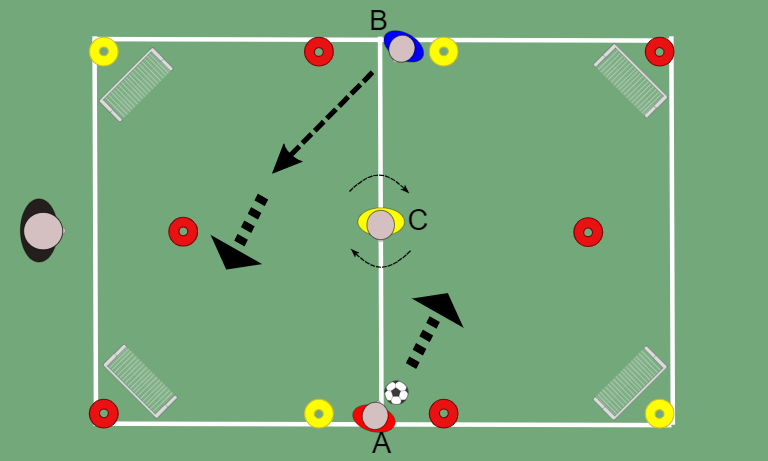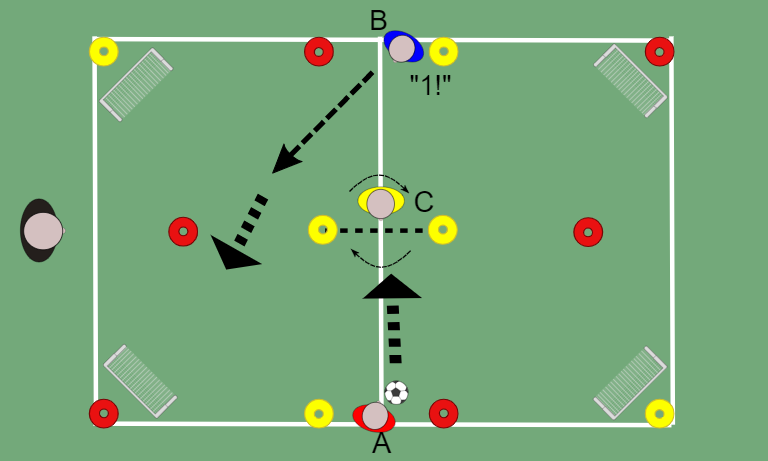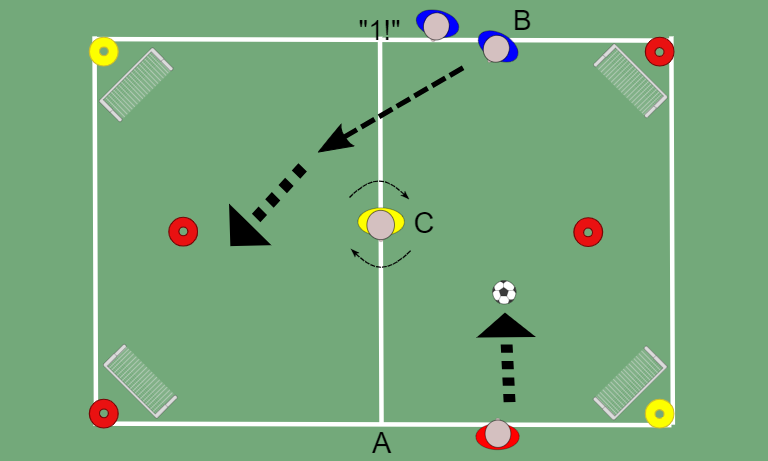EXPLANATION OF THE ROUTINE
The routine consists of varies fundamental movement skills, such as jumping & landing. In this routine, two players (A & B) are going to pass the ball between each other trying to hit a third player (C) below the knees. The latter needs to avoid the ball by jumping and turning. After landing, the action continues with a quick game situation, where C is offender and B is attacker. The end is defined by a successful defence or a successful offence.
PREPARATION
- Place 4 goals at the edges of the field.
- Place two cones near the central spot (middle field) to mark the jumping-landing area.
EXECUTION OF THE ROUTINE
In this routine, the primary context is an outdoor sports area where football coaches regularly perform the practice sessions at a club. The routine can be used as warming-up for different types of goals in football (i.e. jumping, defending, attacking, scoring, etc.) or as a core exercise in a training session.
ADDITIONAL INFORMATION: HOW DO WE REACH OPTIMAL MOTOR LEARNING AND APPLY SELF-DETERMINATION?
- Decision making will stimulate adaptive motor control: Multidirectional skills in an open unpredictable environment are incorporated, defender/attackers must anticipate/react depending on quick changes in the environment (e.g. color change, passing, other players, space and time restrictions).
- Implicit motor learning: This is stimulated with the external focus / analogy examples of instructions/feedback to improve body posture when jumping and landing.
- Challenge/fun: Beating the opponent (challenge) to collect a winning point (fun/gamification by making this a game: most scored points, best performed jumps, chosen for most difficult jumps).
- Motivation: Enhanced by providing autonomy and replicating various realistic in game situations (jump tasks, defending/attacking, scoring) stimulating a safe challenge between players (e.g.: give a point when successfully defended will increase the competition between players).
- Autonomy: Make the players choose or control different aspect of the play (e.g.: role attacker/defender; which jumps to perform, when to start the game; which type of balls to practice with, etc.).
- Competence: Feeling of competence is created by giving the child option to choose a variation of the exercise (by means of level or material).
- Relatedness: Feeling of relatedness is created by the sport specificity with their peers + by feeling most related by which option they have chosen from.
- Differentiation (age/difficulty): The routine is made in order to be easily adapted by the coach for various players ‘
POSSIBLE VARIATIONS
- Instead of only one pass from player A to B, you can choose to say the players can do between 1, 3 or 5 passes. Each time, player C has to jump and turn facing the new passer. The ball still arrives at player B (after 1, 3 or 5 passes), after which B will start attacking.
- Player A can determine the number of passes per time, without player C knowing this, which will stimulate player C to stay focused and anticipate / react appropriately (increases challenge- increased fun).
- Make ‘moving optimally’ a game. That means player C can get points by landing correctly (in terms of landing technique for the prevention goal – coach will observe).
- Player A can choose type of jump for player C by shouting a color (e.g.: green = squat jump; red = countermovement jump; blue = high jump; etc.)
- Player A can observe and give points (1 point or 2 point for execution of the jump) to player C jump performances.
- Players can turn roles when a goal is scored by moving clockwise (e.g.: player B changes to A’s position; players A changes to C’s position; player C changes to B’s position).
- Adding time pressure: whoever/which team scores most goals (points) within that time?
- Player A plays the ball to player B crossing a given area (2 red cones – middle field – player C position).
- Player C stays between the cones while player A is trying to hit him/her with the ball (below the knees) while passing the ball to player B.
- Player C tries to avoid the ball by jumping, turning and landing in a bipodalic position.
- As soon as the ball crosses the middle field (and player C performs his/her task), player B receives the pass and starts playing (1vs1) against player C.
- Player B is now attacking and is allowed to score in one of the two goals in front of him/her (player A’s baseline).
- Player C now defends player B attacking actions trying to prevent the opponent (player B) from scoring.
- If player C steals the ball, s/he may score on one of the two goals in front of her (player B’s baseline).
- Player C now gets a bigger space between the cones (wider apart from each other).
- In the meantime, player C will make left-right movements (e.g.: jump right 90° turn-jump left 90 ° turn-jump right 90° turn, two legs jump-land, two legs jump-one leg land, one leg jump-land, crab walk, skater jump-turn/high jump-turn, etc. > his/her choice).
- Player A now will need to vary his/her pass directions (left-middle-right), depending on where player C is.
- Player B receives the pass from player A (the area of player B’s baseline is also larger).
- Now player A will enter the field as second attacker together with player B.
- Even if player A and B play together, they must score on one of the two goals on the teammate’s baseline.



